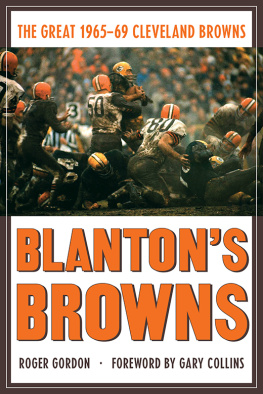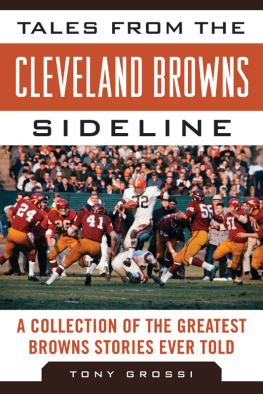Frisky, industrious black squirrels are a familiar sight on the Kent State University campus and the inspiration for Black Squirrel Books, a trade imprint of The Kent State University Press.
No part of this book may be used or reproduced, in any manner whatsoever, without written permission from the Publisher, except in the case of short quotations in critical reviews or articles.
Names: Gordon, Roger, author. | Collins, Gary B., author of foreword.
Title: Blantons Browns : the great 1965-69 Cleveland Browns / Roger Gordon ; foreword by Gary Collins.
Subjects: LCSH: Cleveland Browns (Football team : 1946-1995)--History.
In his eight seasons as the Cleveland Browns head coach from 1963 through 1970, Blanton Collier directed us to seven winning seasons, five playoff berths, four NFL championship games, and the 1964 league title. Imagine what we could have done had he actually been able to hear what we, the players, and his assistant coaches were saying when trying to speak to him! Blanton was plagued by some serious hearing problems. He was a great coach and I loved playing for him, but the guy was deaf! He couldnt hear squat! Despite his ear issues, we were among the finest teams in the NFL for most of his tenure as head coach. Our 1963 team improved from a 761 record the year beforethe franchises second-worst mark ever up to that pointto a 104 record that nearly brought us the Eastern Conference title.
Of course, everybody knows about our 1964 NFL championship, in which we defeated the heavily favored Baltimore Colts 270 in the title game. As good as that 1964 team was, though, I believe that most of our teams during the rest of the decade were even better. We just couldnt get over the hump by winning the big game. We lost to Green Bay for the championship in 1965. The next season, a Thanksgiving defeat to the up-and-coming Cowboys essentially cost us the East crown. We lost badly to Baltimore and Minnesota, respectively, in the 1968 and 1969 NFL title games, costing us berths in Super Bowl III and Super Bowl IV.
I had a pretty successful run with the Browns. In fact, my career statistics are similar to those of Hall of Famer Lynn Swann, a wide receiver for the Pittsburgh Steelers from 1974 through 1982. Swanns Steelers played in, and won, four Super Bowls from 1974 through 1979. Swann was an exceptional talent and is certainly deserving of being in the Hall of Fame, but without those Super Bowl wins, would he be in the same situation I am inhaving to buy a ticket to enter the hallowed hall? I am convinced, if I may humbly say, that our championship-game defeats to the Packers, Colts, and Vikings have kept a handful of our players, including myself, out of the pro grid shrine.
Would I rather that wed won those three championship games? Of course. Would I like to see my bronze bust in the Hall of Fame one day? No doubt about it.
But even if Im never enshrined into the Hall of Fame, I will always have fond memories of being a member of those magnificent Browns teams in the late 1960s. We had great players, great coaches, great fans, and a great stadium. I will never forget being a part of the pomp and pageantry, the excitement and exhilaration, that surrounded the 196569 Cleveland Browns.
When Cleveland Browns fans think of the good old days, successful eras during the 70-year history of the franchise, it seems like there are four that always come to mind.
And with good reason.
One is the Otto Graham period from 1946 through 1955, in which the future Hall of Fame quarterback led the Browns to 10 straight championship games, seven of which they won. Another is the 1964 Browns, who shocked the Baltimore Colts for the franchises last NFL title. The 1979 and 1980 Kardiac Kids will hold a special place in fans hearts forever, as will the Bernie Kosarled Browns of the late 1980s, who were on the doorstep of the Super Bowl three times.
One prosperous era in Browns annals that seems to get brushed under the rug for some reason is the period from right after the 1964 championship to just before the first ABC Monday Night Football game on September 21, 1970, in which the Browns defeated Joe Namaths New York Jets.
That period is the one that ended 50 years ago196569.
The 196569 Browns were wildly successful. The 1965 team came close to repeating as NFL champion, falling to Green Bay in the title game after trailing by just a single point at halftime. The 1966 and 1967 teams each finished 95, the latter of which won the first of three consecutive Century Division championships. The 1968 and 1969 Browns both upset the Dallas Cowboys in the playoffs and came within one win of qualifying for the Super Bowl.
Not only were the Browns of the late 1960s one of the finest teams in the NFL, they were stocked with star players. There were Hall of Famers Paul Warfield, Leroy Kelly, Gene Hickerson, and Lou Groza. And, of course, there was the teamsand possibly the NFLsgreatest Hall of Famer, Jim Brown, albeit in 1965 only.
According to home attendance figures from that era, the city of Cleveland and Northeast Ohio seemed to be excited about the Browns success. The following are the teams average home attendance figures from 1965 through 1969:
196579,612
196677,750
196777,830
196875,430
196982,623
The 1965 Browns attracted five home crowds of 80,000 or more. The 1966, 1967, and 1968 teams each drew three home crowds of 80,000 or more. The 1968 Browns drew 81,497 fans and 78,410 fans, respectively, for their home playoff games against Dallas and Baltimore. The 1969 Browns attracted crowds of 80,000 or more in all seven of their home games, the only time that has happened in the history of the franchise. Even in the preseason back then, the Browns drew huge crowds. In five home exhibition gamesone per seasonfrom 1965 through 1969, they averaged 84,244 fans per contest! Each of those five games was the nightcap of doubleheaders that included two other professional teams, a series that lasted from 1962 through 1971, but even so, the numbers were impressive.
Which brings us to the $64,000 question: With all of the success and great players they had, and with those astronomical attendance figures, why do the late 1960s Browns teams seem to be forgotten? I dont have the answer, but I am hoping that Blantons Browns: The Great 196569 Cleveland Browns will inspire readers to recognize just how significant those Browns teams were to the history of the franchise, and give them the credit they deserve.


















